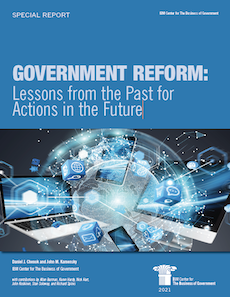
Government Reform: Lessons from the Past for Actions in the Future

This overview of government reforms and actions provides important lessons for leaders today and tomorrow.
Reform approaches will vary, depending on the types of reform are being pursued. Each type relies on different strategic implementation approaches, with different lessons learned that the authors hope will be of value to leaders today.
Strategic Approach 1: Overarching Reform Initiatives: examines reforms that affect the broader governance systems of the federal government and its organization. Examples include the Reinventing Government reform initiative in the 1990s.
Strategic Approach 2: Governmentwide Mission Support Initiatives: examines the evolution of a series of mission support “chiefs” in each agency, often by congressional mandate. These would include positions such as chief financial officers, chief information officers, chief human capital officers, and most recently, chief data officers.
Strategic Approach 3: Initiatives That Enable Mission Delivery: various presidential administrations place an emphasis on developing different capabilities that can improve agencies’ ability to better deliver on their missions. Examples include open government, improving customer service, and fostering innovation.
The report is comprised of a series of essays, each of which is accompanied by a podcast interview with the authors, and other distinguished essay contributors including Allan Burman, Karen Hardy, Nick Hart, John Koskinen, Stan Soloway, and Richard Spires.
Listen to our podcasts "Business of Government Stories" on major reform initiatives over the past 30 years.
Read the Government Executive article and listen to the accompanying podcast, "GovExec Daily: Reflections on 30 Years of Government Reform."



